You can make an effective rosemary flea spray by boiling 2 cups of fresh rosemary in 2 pints of water for 30 minutes, then straining the mixture into a spray bottle. Fresh rosemary contains higher concentrations of camphor, which is toxic to fleas when they ingest it. Apply the cooled spray directly to your pet’s coat, focusing on flea-prone areas, and treat carpets, bedding, and furniture to prevent reinfestation. There’s much more to maximizing this natural solution’s effectiveness.
Why Rosemary Is the Ultimate Natural Flea Deterrent
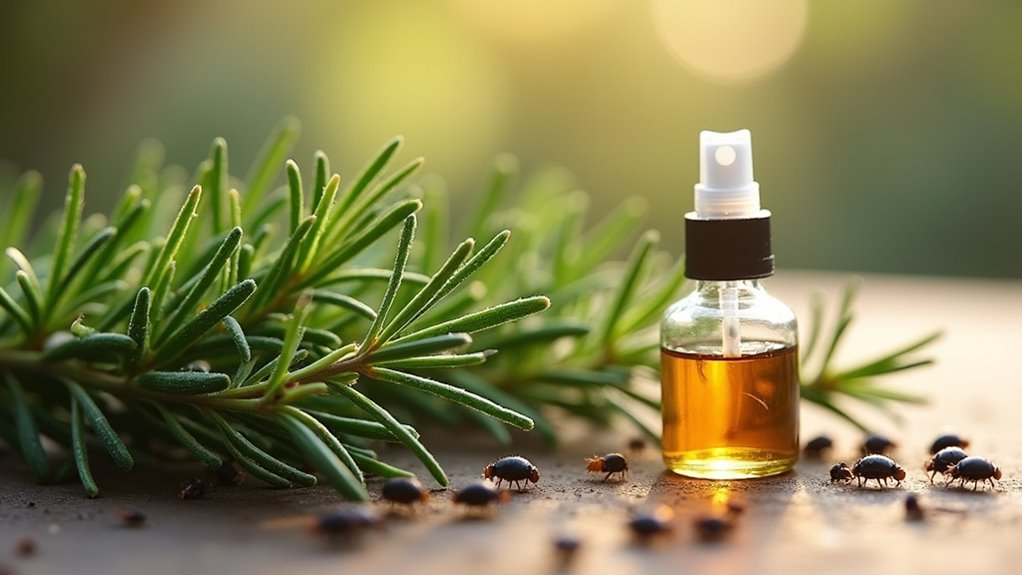
While commercial flea treatments often contain harsh chemicals that can irritate your pet’s skin, rosemary offers a powerful natural alternative that’s both effective and safe. This aromatic herb contains camphor, a compound that’s toxic to fleas when ingested, making it one of the most effective natural flea repellents available.
Rosemary’s natural camphor compound provides powerful flea protection without the harsh chemicals found in commercial treatments.
What sets rosemary apart from other natural flea remedy options is its multi-purpose protection. The herb’s strong scent doesn’t just repel fleas—it also deters ticks, aphids, and flies, giving you extensive pest control.
You can easily grow rosemary in your backyard, creating a sustainable source of protection without relying on store-bought chemicals.
Studies demonstrate that homemade rosemary sprays often outperform commercial flea collars and drops, while filling your home with a pleasant herbal aroma.
Essential Ingredients for Your Homemade Rosemary Flea Spray
You’ll need to choose between fresh or dried rosemary as your primary ingredient, with each option offering distinct advantages for your flea spray’s effectiveness.
The quality of water you use can greatly impact how well the rosemary’s beneficial compounds extract into your solution.
Proper storage and preservation techniques will determine how long your homemade spray maintains its flea-repelling potency.
Fresh Vs Dried Rosemary
When choosing between fresh and dried rosemary for your homemade flea spray, you’ll find that fresh herbs pack notably more punch. Fresh rosemary leaves contain higher concentrations of essential oils, making them considerably more potent than their dried counterparts for flea repellent applications.
To extract maximum effectiveness from fresh rosemary leaves, steep them in boiling water. This process releases the camphor compounds that create the toxic environment fleas desperately avoid.
While dried rosemary can still work as a flea repellent, you’ll need longer steeping times to achieve similar potency levels.
Garden-fresh rosemary offers another advantage: it’s free from preservatives and chemicals found in store-bought dried herbs, ensuring your spray remains completely natural and safe.
Water Quality Matters
Beyond selecting the right rosemary, the water you use forms the foundation of an effective flea spray.
You’ll want to choose distilled or filtered water rather than tap water. Contaminants in untreated water can interfere with your rosemary’s natural compounds, reducing the spray’s potency against fleas.
When preparing your solution, always use boiling water to steep the rosemary. This high temperature extracts the essential oils more efficiently, creating a stronger repellent.
The ideal ratio is 2 cups of fresh rosemary to 2 pints of water – this balance maximizes effectiveness without wasting ingredients.
After steeping, let the rosemary-infused water cool completely before straining.
This cooling process helps preserve and concentrate the beneficial compounds that make your homemade spray truly effective.
Storage and Preservation
Once you’ve prepared your rosemary flea spray, proper storage becomes the key to maintaining its effectiveness.
Store your homemade solution in a clean, airtight spray bottle to prevent contamination and preserve its potency. You’ll want to refrigerate the spray immediately after preparation, as cool temperatures help maintain the natural ingredients’ strength over time.
Always shake the bottle thoroughly before each use since natural solutions tend to separate. Label your spray bottle with the preparation date and use it within two weeks for best results.
Fresh rosemary produces the most potent spray, so avoid using dried herbs when possible. Proper storage practices guarantee your flea spray remains effective throughout its recommended shelf life.
Step-by-Step Instructions to Create Powerful Rosemary Flea Repellent
Now that you’ve identified the essential ingredients, you’ll learn exactly how to transform fresh rosemary into an effective flea-fighting solution.
The process involves three critical stages: gathering your rosemary and equipment, properly boiling and straining the mixture, and applying the spray correctly for maximum protection.
Follow these straightforward steps to create a potent natural repellent that’ll keep fleas away from your pets and home.
Gather Essential Rosemary Ingredients
While creating an effective rosemary flea spray requires minimal ingredients, you’ll need to gather the right materials before starting the preparation process. The foundation of your homemade flea repellent consists of just two primary components: fresh rosemary and water.
You’ll need exactly 2 cups of fresh rosemary sprigs and 2 pints of clean water to create this natural solution that’ll combat your pet’s flea infestation.
Beyond these core ingredients, make sure you have a large pot for boiling, a fine-mesh strainer for removing plant material, and a clean spray bottle for application. Having these items ready streamlines the entire process.
Fresh rosemary works best, though dried rosemary can substitute if necessary. Quality ingredients produce more potent results against fleas.
Boil and Strain Process
With your ingredients assembled, you’re ready to begin the straightforward boiling process that transforms ordinary rosemary into a potent flea-fighting solution.
Start by bringing 2 pints of water to a rolling boil in your pot. Once bubbling vigorously, add 2 cups of fresh rosemary leaves and let them steep for 30 minutes. This extended steeping time extracts the essential oils that give rosemary its flea-repelling properties.
Remove the pot from heat and allow the mixture to cool completely before handling.
Once cooled, strain out all rosemary leaves using a fine mesh sieve or cheesecloth. You’ll be left with an aromatic, amber-colored liquid.
Pour this concentrated solution into your spray bottle and refrigerate for storage. Your homemade flea repellent is now ready for application.
Proper Application Techniques
Once you’ve prepared your rosemary flea spray, proper application guarantees maximum effectiveness against these persistent pests. Use a cotton ball or sponge to apply the solution directly onto your pet’s fur, saturating areas where fleas typically hide like behind ears, under legs, and around the neck.
Don’t just spray randomly—work systematically to guarantee complete coverage.
Spritz your pet daily to maintain a protective barrier against new infestations. The rosemary flea spray works beyond just your animal; treat pet bedding, carpets, and furniture where fleas lay eggs and larvae develop.
This all-encompassing approach targets the entire flea lifecycle, preventing reinfestation. Focus on areas your pet frequents most, creating an environment that’s hostile to fleas while keeping your companion comfortable and protected.
How to Properly Apply Rosemary Spray on Your Pets
Proper application of rosemary flea spray requires careful attention to both timing and technique to guarantee your pet’s safety and comfort.
First, make sure the spray has cooled completely after preparation to prevent skin irritation. Apply the rosemary flea spray directly onto your pet’s coat, concentrating on flea-prone areas like the neck, back, and tail while avoiding eyes and mouth.
Use a flea comb to work the solution through your pet’s fur, ensuring even coverage and helping dislodge existing fleas. Apply daily for ongoing protection or after outdoor exposure.
Always monitor your pet for adverse reactions after application, and consult your veterinarian if you notice irritation or discomfort.
Using Rosemary Spray to Treat Infested Home Surfaces
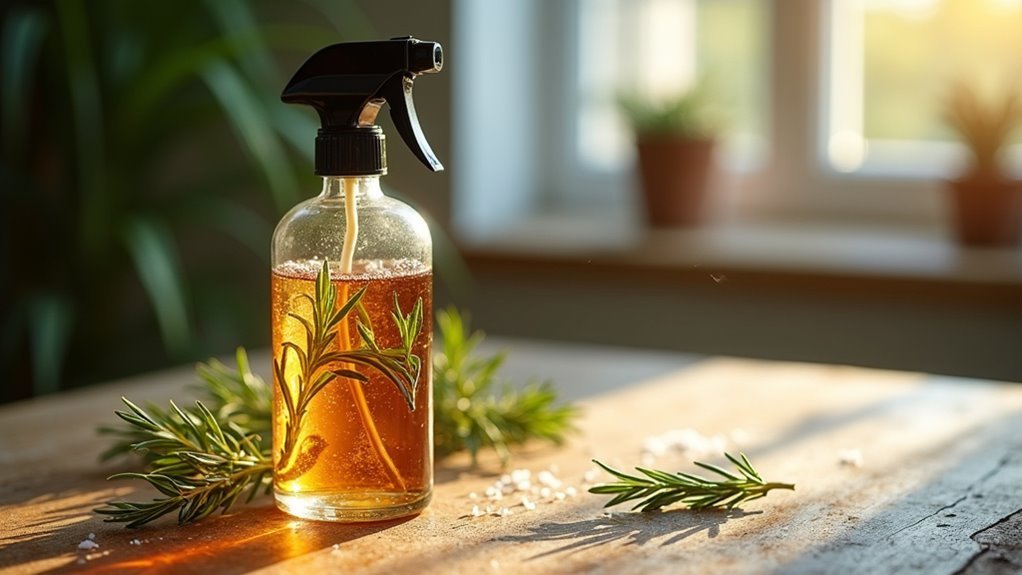
When treating your home’s infested surfaces with rosemary spray, you’ll need to focus on high-traffic areas where fleas congregate most frequently.
These hotspots include carpeted areas near entryways, pet sleeping zones, and upholstered furniture where your pets spend time.
Proper application techniques and thorough coverage guarantee you’re maximizing the spray’s effectiveness against existing flea populations.
Target High-Traffic Areas
Three key areas require your immediate attention when applying rosemary flea spray to combat home infestations: carpets, furniture, and pet bedding.
These high-traffic areas serve as primary breeding grounds where fleas hide, multiply, and jump between surfaces. You’ll need to spray carpets and rugs thoroughly, as they trap flea eggs and larvae in their fibers.
Don’t overlook furniture and upholstery—fleas easily leap onto these surfaces from pets or floors, causing re-infestation cycles.
Focus specifically on corners, crevices, and spaces under furniture where dust and flea eggs accumulate.
Combine your rosemary flea treatment with thorough vacuuming to remove adult fleas, larvae, and eggs effectively.
This dual approach will prevent fleas from establishing new colonies and help eliminate existing flea infestations completely.
Application and Coverage Tips
Since rosemary flea spray’s effectiveness depends on proper application technique, you’ll need to apply it systematically across all infested surfaces for maximum impact.
| Surface Type | Application Method | Coverage Notes |
|---|---|---|
| Carpets/Rugs | Direct spray | Guarantee even coverage to reach hidden eggs |
| Pet beds/Cushions | Thorough soaking | Target areas with high flea activity |
| Furniture | Direct spray or wipe | Use cotton ball for crevices and corners |
| Hard surfaces | Cotton ball/sponge | Wipe down thoroughly for complete treatment |
Allow the spray to dry completely on all treated surfaces to enhance its repellent properties. You’ll need to reapply every few days, especially in areas showing continued flea activity, to maintain an effective barrier against reinfestation.
Creating Rosemary Powder for Extended Flea Protection
Creating your own rosemary powder offers a simple yet effective way to extend flea protection throughout your home. Start by drying fresh rosemary leaves in a warm, dark place until they’re completely dehydrated.
Once dried, crush them into fine dust using a mortar and pestle or spice grinder to create your herbal flea powder.
This natural flea repellent can be sprinkled directly onto your pet’s fur or around household thresholds for additional protection.
You’ll also want to apply the rosemary powder to carpets and pet bedding, where it acts as a deterrent while absorbing moisture that attracts fleas.
This safe flea prevention method works perfectly for households with children and pets, replacing harsh chemical pesticides while leaving a pleasant herbal scent throughout your living spaces.
Combining Rosemary With Other Natural Flea-Fighting Ingredients
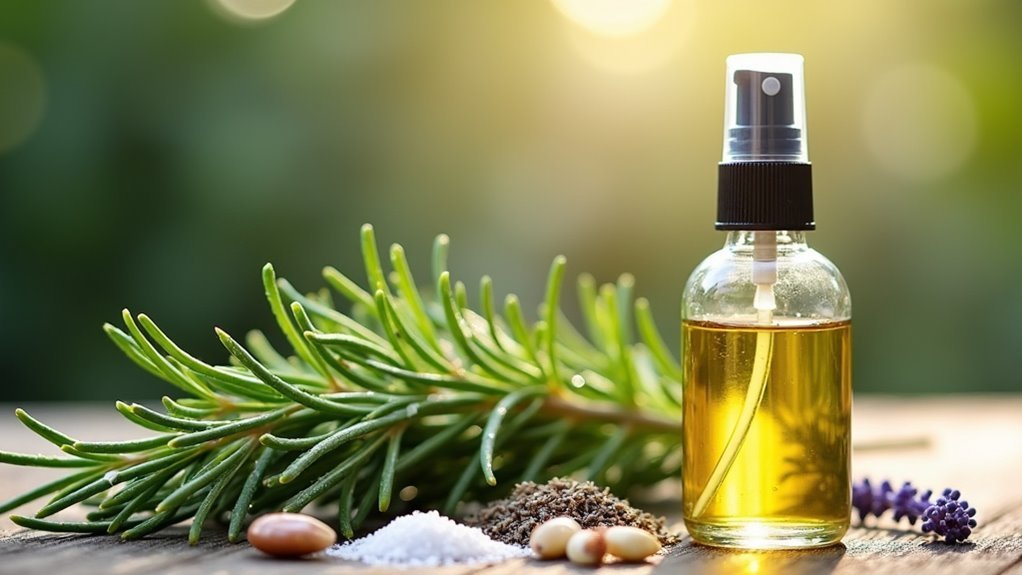
While rosemary works effectively on its own, combining it with other natural ingredients creates a more powerful flea-fighting arsenal that targets multiple aspects of flea prevention and elimination. You’ll maximize your spray’s effectiveness by pairing rosemary with complementary natural repellents.
Apple cider vinegar enhances rosemary’s properties through its acidity, which disrupts flea pH balance. Mix equal parts for best results. Adding neem oil provides insecticidal properties that disrupt flea life cycles while soothing pet irritation. Lavender essential oil contributes additional insect-repelling qualities with a calming aroma.
| Ingredient | Primary Benefit | Mixing Ratio |
|---|---|---|
| Apple Cider Vinegar | pH disruption | 1:1 with rosemary |
| Neem Oil | Life cycle disruption | 1-2% of total volume |
| Lavender Essential Oil | Enhanced repelling | 10-15 drops per cup |
Safety Guidelines When Using Rosemary Treatments on Cats and Dogs
Though these natural combinations offer powerful flea-fighting benefits, you must prioritize your pet’s safety when applying any rosemary-based treatment. Following proper safety guidelines protects your furry companion from potential harm.
Cats are particularly sensitive to essential oils, so you’ll need to use extremely diluted concentrations. Always perform a patch test on a small skin area before full application to check for allergic reactions.
- Never spray rosemary treatments directly on your pet’s face – their eyes, nose, and mouth are vulnerable to irritation.
- Watch for distressing symptoms like excessive licking, vomiting, or breathing difficulties after application.
- Discontinue use immediately if any adverse reactions occur.
You should consult a veterinarian before starting rosemary treatments, especially for pets with health conditions or pregnant animals.
How Long Rosemary Flea Spray Remains Effective
Understanding the effectiveness duration of your rosemary flea spray helps you plan proper application schedules and maintain consistent flea protection.
Your homemade spray remains effective for one to two weeks when stored in a cool, dark place. Refrigeration extends this timeframe, while exposure to sunlight or heat degrades rosemary’s active compounds.
Store your rosemary flea spray in cool, dark conditions to maintain effectiveness for up to two weeks.
When you apply the spray directly to your pet, protection lasts approximately 24 hours. You’ll need to reapply every few days during peak flea season or after bathing your pet for continuous coverage.
The spray’s potency diminishes over time, so don’t rely on old batches for maximum effectiveness.
Since rosemary’s natural ingredients are safe for regular use, you can apply frequently without worrying about chemical buildup on your pet’s coat.
Storage Tips to Maximize Your Rosemary Solution’s Shelf Life
Since proper storage directly impacts your rosemary flea spray’s potency and longevity, you’ll want to follow specific guidelines that preserve its natural compounds.
These storage tips will help maintain your spray’s effectiveness:
- Store in darkness – Keep your airtight spray bottle in a cool, dark place where light won’t degrade the active ingredients.
- Embrace refrigeration – Cold storage extends shelf life up to two weeks, protecting your investment in flea control.
- Track freshness religiously – Label with preparation dates so you’re never caught using expired solution on your beloved pets.
Always shake before use since natural ingredients separate over time. An airtight spray bottle minimizes air contact that reduces potency.
With proper refrigeration and these storage practices, you’ll maximize your rosemary solution’s shelf life while ensuring consistent flea-fighting power when you need it most.
Signs Your Rosemary Flea Treatment Is Working
How can you tell if your rosemary flea spray is actually delivering results? You’ll notice several clear indicators within days of application. Your pet’s scratching and irritation will markedly decrease, and you’ll see improved overall comfort through increased playfulness and reduced restlessness.
| Positive Signs | What to Look For |
|---|---|
| Reduced Activity | Fewer flea bites on pets and humans |
| Clean Environment | Less flea dirt on pet beds and furniture |
| Trap Results | Decreased flea counts in home traps |
The absence of tiny black specks (flea dirt) on pet beds indicates your flea infestation is diminishing. Strategic flea traps will show fewer captures, confirming the spray’s ability to help repel fleas effectively throughout your home environment.
Troubleshooting Common Rosemary Spray Application Issues
While positive results should appear within days, you might encounter application challenges that reduce your rosemary spray’s effectiveness. Most issues stem from preparation or application mistakes that are easily corrected.
Common problems include:
- Your beloved pet showing skin irritation – dilute it with water immediately and test on a small area first.
- Weak spray that barely repels fleas – use fresh rosemary leaves in boiling water for maximum potency.
- Inconsistent coverage leaving flea hideouts – apply the spray systematically to all fur areas and bedding.
It’s important to note that reapplication every few days maintains effectiveness.
If problems persist, combine your rosemary spray with other natural repellents like vinegar.
When to Reapply Rosemary Flea Repellent for Best Results
Timing your rosemary flea repellent applications correctly determines whether you’ll achieve lasting protection or find yourself battling persistent flea problems.
You’ll need to reapply your rosemary spray every 2-3 days during peak flea season, especially in humid conditions where fleas multiply rapidly.
After bathing your pet, immediately refresh the application since water washes away protective residues. Outdoor adventures and exposure to flea-infested areas also warrant immediate reapplication.
Don’t forget your home environment – treat bedding and carpets weekly to disrupt the flea life cycle and eliminate newly hatched eggs.
If you notice increased scratching or visible flea activity despite recent treatment, reapply the spray immediately rather than waiting for your scheduled application.
Consistent timing creates an impenetrable barrier that keeps your pet comfortable and flea-free.
Enhancing Rosemary Effectiveness With Proper Home Maintenance
Five critical home maintenance practices will amplify your rosemary flea spray’s effectiveness and create an environment where fleas can’t establish a foothold.
Regularly vacuuming carpets, rugs, and pet bedding removes flea eggs and larvae that your spray can’t reach.
Wash your pet’s bedding in hot water weekly to eliminate hidden populations.
Keep your yard maintained by mowing grass and removing debris to destroy outdoor flea habitats.
- Your heart will sink watching your pet scratch constantly despite your best efforts
- You’ll feel frustrated when fleas keep returning to reinfest your treated pet
- Relief will flood through you seeing your pet finally comfortable and flea-free
Combine diatomaceous earth with your rosemary spray for maximum impact.
Treat both your pets and their surroundings consistently to prevent reinfestation cycles.
Frequently Asked Questions
How Do You Make Rosemary Spray for Fleas?
You’ll boil 2 pints of water, add 2 cups of fresh rosemary, and simmer for 30 minutes. Strain the mixture into a spray bottle, then regularly spritz your pet’s fur.
What Is the Best Homemade Spray to Kill Fleas?
You’ll find rosemary flea spray works best by boiling two cups fresh rosemary in two pints water for thirty minutes, then straining into a spray bottle for effective flea control.
Can I Spray Rosemary Water on My Dog for Fleas?
Yes, you can safely spray rosemary water on your dog for fleas. The camphor in rosemary repels and kills fleas while leaving a pleasant scent. Just avoid spraying near their eyes and mouth.
What Kills 100% of Fleas?
You can’t achieve 100% flea elimination with any single method. However, you’ll get closest by combining professional pest control treatments with diatomaceous earth, essential oils, thorough vacuuming, and washing pet bedding regularly.
In Summary
You’ve now mastered creating and using rosemary flea spray that delivers real results. Remember, consistency is key—you’ll need to reapply every few days and maintain a clean environment for maximum effectiveness. Don’t get discouraged if you don’t see immediate results; natural remedies take time to work. Keep applying the spray regularly, vacuum frequently, and you’ll soon notice fewer fleas bothering your pets and invading your home spaces.

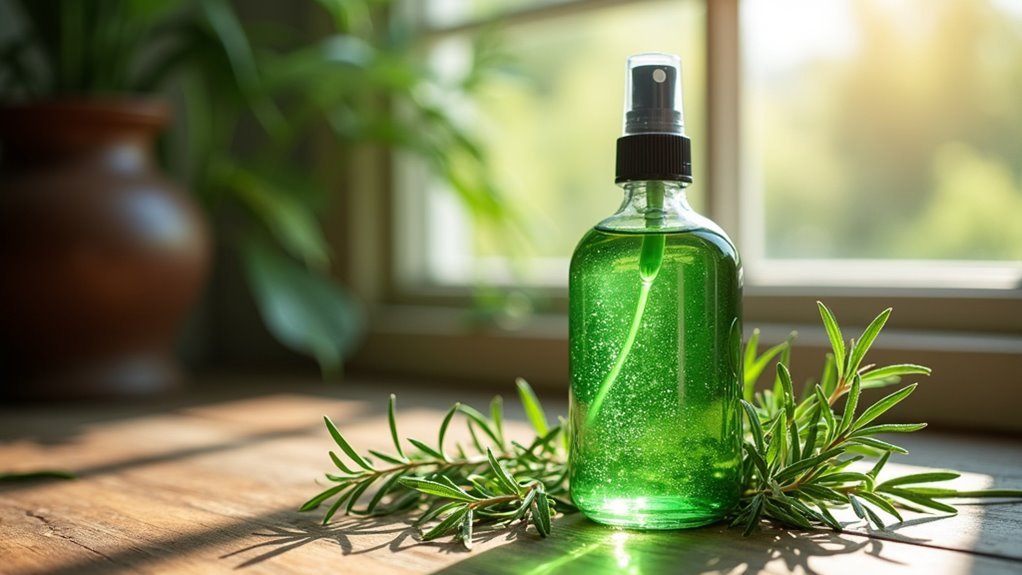


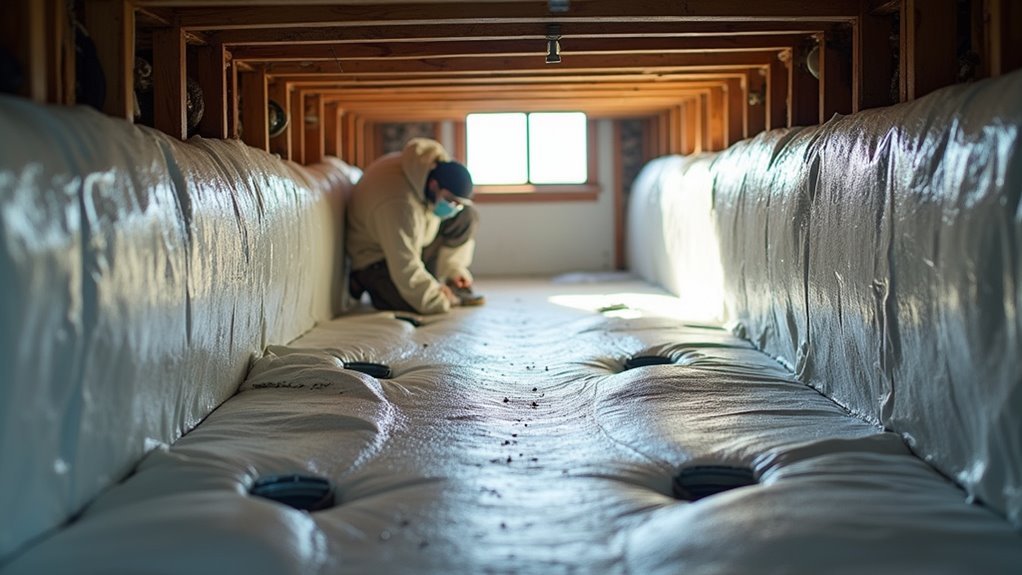
Leave a Reply